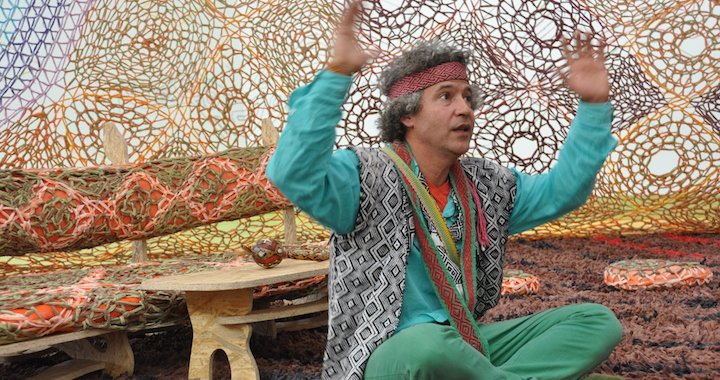
Live light!
An interview with Brazilian artist Ernesto Neto
15/03/2016
After this interview, when I double-checked the spelling of a few Huni Kuin words, I received an email from Ernesto Neto that ended with the words “Live Light. Haux.” In Portuguese, “haux” means something like “Viva!” or “Live!”
Light, or lightness, is also probably the best word to describe Neto’s artwork. And, in a way, the Brazilian artist himself. Not physical lightness, but the lightness of the senses and the mind. “Don’t touch” is a phrase that does not exist in Neto’s vocabulary. His art involves practically all of the senses – touch, sight, hearing, smell – thereby allowing visitors to wander around, touch, delve into, wade into, forget themselves and find themselves anew in the artist’s gigantic installations (Neto calls them sculptures), whose abstract forms take on almost human-like shapes. In the truest sense of the word, they allow the visitor to feel a weightlessness of the senses that cleanses them of the pollution of daily routines and frees up space for new thoughts and ideas.
Born in 1964, Ernesto Neto (his real name is Ernesto Saboia de Albuquerque; the nickname Neto means “grandson”) is at the moment the best-known Brazilian artist. He once dreamed of becoming an astronomer and read Newton, Einstein, Bohr and Heisenberg, but he failed the university entrance exam. He then encountered art by chance, when a girlfriend took him to a ceramics activity. But Neto has never lost his interest in gravitation, science and cellular structure.
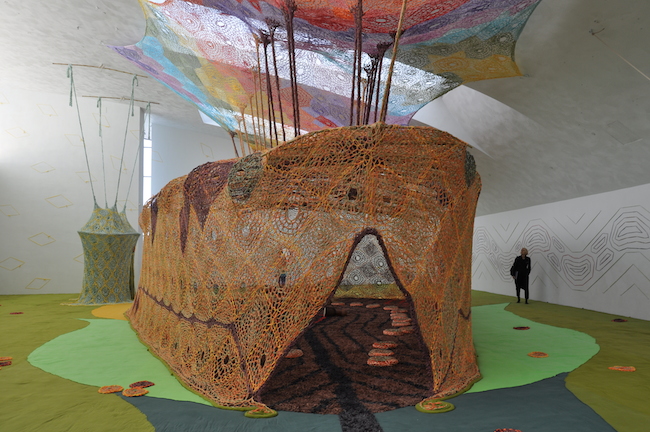
Ernesto Neto. Boa (2016), KIASMA, Helsinki. Photo: Ainars Erglis
Brazil’s Neo-Concretism movement (1959-1961), best known from the artwork of Lygia Clark and Hélio Oiticica, is often cited as one of Neto’s sources of inspiration. His first exhibition took place at the Petite Galerie in Rio de Janeiro in 1988, while he made his international debut in 1996 in Chicago, California and Madrid. In 2001, his exhibition Ô Bicho! – in which visitors wandered among stalactites made of nylon fabric and filled with pepper, cloves and turmeric, constantly smelling the air and inadvertently rocking the artwork with their impatient, curious noses – became a sensation at the 49th Venice Biennale’s main exhibition, curated by Harald Szeemann. In 2006 Neto’s monumental sculpture Léviathan Thot was displayed in Paris’ Panthéon, where the mystical “aromatic monster” reached from the top of the domed ceiling down to the floor, letting visitors completely forget about the reality (including the actual space) in which they found themselves.
In 2010, the Hayward Gallery in London showed Neto’s largest work of art to date – a series of installations about which the artist said in an interview: “Our bodies consist of four million cells, and that means four million microorganisms inside of us. This exhibition, and all of my work, is about that.”
With his installation Life is a River, Neto also participated in India’s first art biennale, the Kochi-Muziris Biennale in 2012. Coincidentally, the biennale takes place in Kochi, the historical heart of the ancient spice trade route. Neto’s famous “sacks of spices” were hung in the attic of a 400-year-old building that once housed a coconut-fibre company. One had to climb an old, dusty wooden ladder and crawl through a hatchway to see the work. The air in the sun-heated attic was so hot and dense with aromas that you could stir it like a curry. Neto had found the orange fabric for his spice-filled “stockings”, which slightly resembled full cows’ udders, at the local market in Kochi.
By the time Neto showed his exhibition The Body that Carries Me at the Guggenheim museum in Bilbao in 2014, he had already met the Huni Kuin people living along the banks of the Jordão River near Brazil’s border with Peru. As he’s stated in previous interviews, the name for the exhibition came to him during a ritual. He had wanted to create the exhibition as a materialised poem, a poetic space into which one could flee from the chaotic mill of daily life. “We are constantly receiving information, but I want this to be a place where we stop thinking, where we take refuge in art. I think that not thinking is healthy; it's like breathing life itself,” he explained.

Ernesto Neto. CanoeKeneJaguarPataLampLight (CanoaKeneOnçaPawLampadaLuz), 2015. Courtesy Ernesto Neto. Installation view: Ernesto Neto and the Huni Kuin: Aru Kuxpia | Sacret Secret: TBA21-Augarten © Jens Ziehe, Vienna 2015
And the exhibition Aru Kuxipa | Sacred Secret | Sagrado Segredo followed in the autumn of 2015. Shown at the TBA21 art space in Vienna, Neto created it together with the spiritual leaders of the Huni Kuin people, known as pajés. There, in the old Baroque-style Augarten park in the centre of the Austrian capital, they constructed a meditative space for rituals and meetings, called a kupixawa in the Huni Kuin language, thereby providing a platform for dialogue between the modern Western world and the Huni Kuin culture and their ancient knowledge. Neto believes that this dialogue is the only chance humans have for survival in this world. In November 2015, he and members of the Huni Kuin tribe, as well as well-known Austrian patron of the arts Francesca von Hapsburg, participated in the Global Climate March with a sign stating “Earth – our body”.
My conversation with Neto took place in a giant crocheted cave resembling a boa constrictor’s head. In other words, we met at the very heart of his exhibition titled BOA at the KIASMA contemporary art museum in Helsinki. It’s the place Neto calls the temple. It had been over an hour since the exhibition’s opening event, in which Neto spoke for 50 minutes about his experiences with meeting the Huni Kuin people, art, his participation in shamanistic rituals and the world in which we live today (read the excerpt of his speech here), and I was the last in line to interview him, following a string of interviewers from Finnish television and radio. The strict museum schedule anticipated 40 minutes for our interview – longer than the others – but we spoke for over an hour. Even though sometimes Neto juggles words as masterfully as he manages double and triple crochet stitches (which he recommends everybody try!), each of his thoughts is based in his own experiences. “When I got to the Huni Kuin and began to understand this indigenous spirit, I began to better understand what I was doing. It was not something that changed the direction of my work, it just created another dimension to it. Ideas that were around all the time are now clear. I can talk about them,” he says.
Quite a few years ago, in the Brazilian rainforest near Manaus, we met an Indian man. He knew ten languages – he had learned them from cassette tapes – and he worked as a guide in the rainforest in order to support his family, which lived 400 kilometres up the Amazon River. He went by boat to visit with them once a month. He told us that Western pharmaceutical companies were cutting down the big trees there and destroying the rainforest. When a one-hundred-year-old tree falls, it shatters the entire ecosystem around it....
You know what the Huni Kuin people have found? That the soil in Amazonia is not very rich, but the roots of the trees are so connected that one tree can begin to give another tree what it needs. This is beautiful, this is divine. That is the feeling that we are missing as humans. Human beings could be so much more than just this rational and cultural dimension that we have, which we value so fanatically. These guys (the Huni Kuin – Ed.) are full of this knowledge, and yet other people are crushing them: “Oh, these guys are idiots. They say these things about the mountains, rivers and plants.”
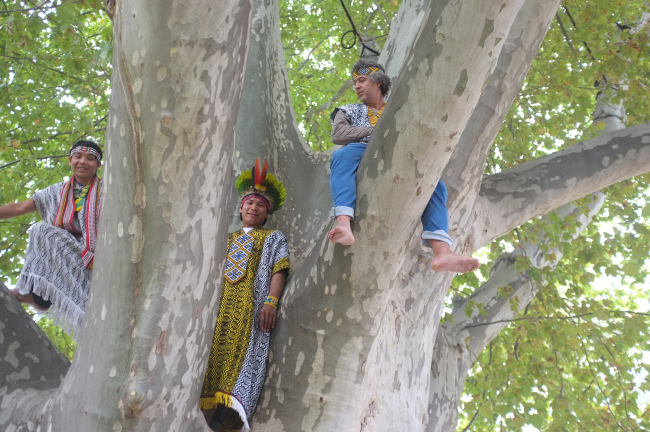
Ernesto Neto and Brazilizna indians at TBA21. Ernesto Neto and the Huni Kuin: Aru Kuxpia | Sacret Secret: TBA21-Augarten © Jens Ziehe, Vienna 2015. Photo: Girts Muiznieks
The Andean people of Peru and Bolivia call the earth Pacha Mama. They believe that the earth is alive and that it functions, like a human being, as an entire organism. According to the ancient Inca calendar, the world has now entered the tenth cycle of development (the tenth Pachakuti), which is an era of light and whose main task is to find balance. Because Pacha Mama is tired, because people are slowly killing her.... Do the Huni Kuin perceive the earth in a similar manner?
It's the same thing. Pacha Mama is the spiritual dimension of nature. And we are killing this fountain of light, love, health, serenity, peace. This is not very good; it's like killing yourself little by little. I think there is no doubt, a lot of people on this planet already know that we cannot keep going the way we are. We need to slow down, to undevelop. You know, for “development” in Portuguese we say “desenvolvimento”. “Des” is a negative prefix that comes before evolvement. So, development is not evolvement, it’s doing things without evolving. It's like neutralising the room to have an art experience without evolvement. But already a hundred years ago quantum mechanics told us that there is no way to ask a question without interference of the ambience. Because, on this dimension, whenever you ask a question, you’re already interfering with the environment of particles. According to Werner Heisenberg’s uncertainty principle, the more precisely you determine an elementary particle’s location, the less precisely you can determine its speed. And, the nearer you get to its speed, the harder it is to determine its location. I think science is already saying that, but businesses don't want to see it. They just want to see profits. And the next tree to be cut.
Do you believe it can be changed some day?
Yes, I believe so. I think we’re living in a tragic moment. No doubt about it. But I believe that the force of nature, the force of the pacha mama guided and translated by indigenous peoples everywhere on this planet – in South America, in the East – will have this power to change the world. It's going to happen at some point. There are a lot of people who’ve made the choice to not enter the capitalist system. I think the indigenous people, they all have the same point of view, at least the ones who can. Because sometimes development arrives with such power that it just kicks them out and they have no choice. But many of them keep this spirit inside of themselves.
Do you ever have the feeling that art is a spirit that uses your body, your hands, your brain as a form of media?
Yes, art is a spirit of me. Art is the only place of subjectiveness for Western society. Everything else is objectiveness. Art is a place of spirituality – that's why everybody goes to museums, to concert halls, to the theatre. They are not going to church. That's why I think art is a place of connection. Also with indigenous spirituality. Through art we can talk with them. We can share with them. After I went there (to the rainforest – Ed.), when I came back I realised that all of them are artists in a way. Everyone sings, everyone dances, everyone makes drawings. I thought that maybe there’s a process of evolution in the Western way of seeing things – the direction we are going to. First there were monkeys, then Homo erectus, then Homo sapiens, then Homo modernus and maybe in the future there will be Homo artistis, when all of us are going to be artists.
In Brazil you have the samba, and in the samba, you have a table where people are sitting down and playing guitars, somebody is playing drums, and there are other people standing up and playing matchboxes or just dishes. Everybody is singing and people are dancing. It’s not something where you have a stage and an audience. None of this hierarchical thing. Samba is something that everybody does together, so, this thing of interaction is already in our Brazilian society. It comes, no doubt, from the Africans, and then from the indigenous people mixed with Europeans. So, that's the place I like to be. Being together. For a long time now we’ve had a tradition of having parties on the beach, free for everybody. There are two kind of parties you can do. You can do a party to inflate your ego, and you can do a party to dilute your ego. The second ones are the ones we like to do, when everybody comes together, when there’s this togetherness.
If art is the spirit, and art is the way to connect and make something together with others, then the role of the artist is very important. In other words, the way in which the artist uses his or her power.
There are artists...and then there are artists. In many cases, art is not just a victim of consumer society but also in some way stimulating it. The art scene is part of the consumer society, too. There is the light, and there is the shadow. You need to know how to balance the two. So, there’s a lot of art that is working towards the destruction of everything. These untouchable things. The more untouchable something is, the more valuable it becomes. The more untouchable and unreachable a person is, the more valuable this person is. This is something a little bit sick, because you don't feel very comfortable when you’re acting like that. Your spirit is not very positive. And, for sure, you are not enjoying life as you could...even if you make a lot of money. In Brazil, for example, many people live in big houses and are afraid of everything, and then there are people in the favelas having a wonderful life. An incredible life. Sharing, exchanging, playing, fighting, but a life.
The market dimension in today's art world is very strong. And very shamanic, too. You see something, and suddenly you get swallowed by it and don't know how to get out of it. And in the end you become it. We need to take care with these things.
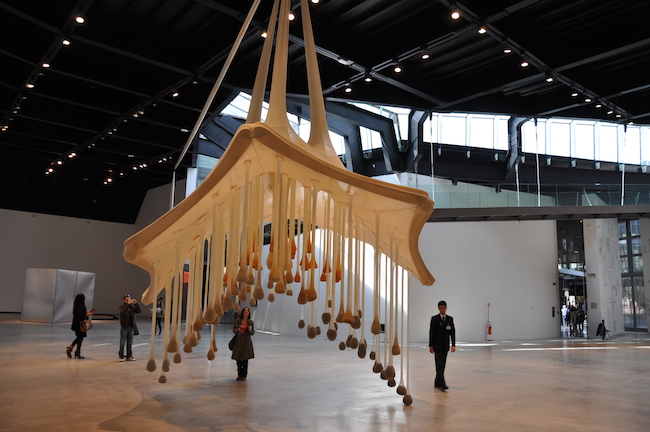
Ernesto Neto. While Nothing Happens (2008), MACRO, Rome. Photo: Ainars Erglis
But, returning to the Huni Kuin, how open are they to communication with Western society, considering the maybe not-so-flattering history of this relationship?
They may be kind of the avantgardists of it all. Because this book (Una Isĩ Kayawa, The Book of Healing – Ed.) they did about healing plants is very controversial. In the book they published pictures of plants with the Huni Kuin name and the scientific name of each plant, because they wanted them to match. Their ancestors, the old shamans, said that one day the time would come – xina benã, the new time – when the indigenous people would open their medicines to cure humanity. And they believe that we are now living in this time. But it's not very intellectual what they believe. So, there was a lot of criticism of the book by anthropologists, and even from other indigenous people, because the medicines are there, but at the same time these medicines are all being stolen. The plants and medicines are in the book, but at the same time they don't have a copyright on the pills people are going to make from those plants. It's only documented in the book that this is their ancestors’ property. If one day society becomes more honest, they’ll receive the profit for it. And that profit might not be measurable in millions of airplanes, but it might be the story of nature. Because what they want most of all is for everything in nature to grow and for the natural ecosystems to not be disturbed.
But, at the same time, a relationship with the white people could create a lot of not so nice things as well. When they receive money, the tribes might begin to do less agriculture, and this is the dark side of it. With everything we do there, we interfere in their society, too. So, this is a very delicate issue. My friends and I have been talking a lot about how to connect with them without, for example, generating the system of social classes and problems of other white civilisation. To not introduce into their society all of those things that we very much want to get rid of ourselves right now. Because in some way they could also get seduced by that.
You need days and a huge amount of energy to row a boat, to move up and down a river. But when you go ta, ta, ta....with a motorboat, it's much quicker, but at the same time it pollutes the river and the fishes go away. It's a very complicated situation that we are living in now, and they know about it and, I'm sure, they think about it a lot, too. It's very, very important to find a way to connect without destroying, but in the meantime it’s also absolutely necessary to connect now in order to protect, to spread this knowledge and this wisdom to the white society.
Unfortunately, there’s no such thing as human rights. Human rights are destroyed when profits arrive. And there are all these institutions helping to uphold this capitalist wave, but the only way of changing – the only cure – will be the day when we realise that we can live much better in community with the forest. By consuming less and exploring less nature and people in general. By living in an ecological and in a social way. Because both of them are related. In my understanding, there is no way for us to have a good future on this planet if we don't listen to the indigenous people. I have no doubt about that. The most significant thing that’s changed in my life since meeting the Huni Kuin and using ayahuasca – this secret medicine – is that there are now things that I have no doubt about. That doesn’t mean that I’m now going to go out into the streets with a flag and try to convince everybody. If you feel differently, if you think differently, that’s fine, too. But I’m convinced that we have no chance of changing anything in this world if we don’t listen to the indigenous people.
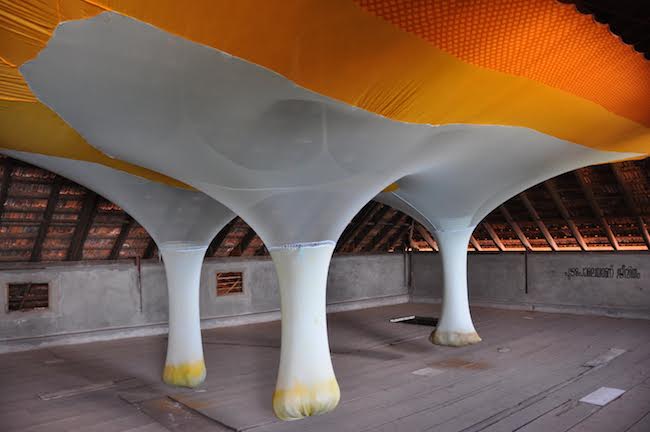
Ernesto Neto. Life is a River (2013), Kochi-Muziris Biennale, Kochi. Photo: Ainars Erglis
A long time ago, we all supposedly had this knowledge. Then, over the course of so-called progress, we lost it all and are now trying to get it back....
There’s a book called Sapiens (Sapiens: A Brief History of Humankind by Yuval Noah Harari – Ed.), which has become a bestseller. The author writes that 70,000 years ago there was a cognitive revolution, or transformation, in Homo sapien, and they began to communicate a lot and to share gossip. They began to learn how to do things together, and that’s when they were able to cross to the Middle East, where the Neanderthal man lived. Then they spread all over Europe, to Africa and Asia. These other humans, like Neanderthal man, they disappeared. 12,000 years ago they crossed the sea; these people were very wise, they managed to navigate to Australia. There were these big animals living in Australia, and afterwards these animals disappeared. And then these people went to South America, to all of America, too, and the same thing happened with the animals there.
According to current scientific thought, there was another intelligence transformation in human beings about 10,000 years ago, when we began to be able to domesticate wheat. But indigenous people think differently. They think that we were domesticated by wheat. Wheat is very demanding. No other plants could be around it – you need to water it, you need to take care of it, you need to build a house near the wheat in order to take care of it. You become very vulnerable, because you are fixed to one place; because the plague can come and destroy your whole wheat plantation. Your quality of eating becomes much lower, because you just eat meat and wheat, whereas before you were eating a lot of things. A lot of different meats, not only cows and sheep and this kind of domesticated animals.
The reality on our planet now is that we make huge plantations – for example, the soy plantations in Brazil are gigantic – to feed the cows, to eat meat. Hamburgers. There are millions of cows and billions of chickens. Who is domesticated? Are we domesticating the chickens, or are they domesticating us? There’s much more kitchen stuff around than human beings. And we’re destroying everything for that. That’s the point. What kind of evolution did we have? We had an evolution that allowed us to produce a mass of food to feed a lot of people. Then we had a demographic explosion, and now we’re living in this demographic explosion, in a world full of these goods, and we don't know how to go back. We don’t know how to become indigenous again, like you said. My clue is spirituality. We need to connect to sacredness, we need to understand that every time, every moment we live is sacred. Every day is poetry, full of micropoetries around us, and this is the sacredness. So, when we really begin to connect with this sacredness, with the spirituality of nature, it will teach us.

Ernesto Neto. A Gente se encontra aqui hoje, amanhã em outro lugar. Enquanto isso Deus é Deusa. Santa gravidade, 2003. Thyssen-Bornemisza Art Contemporary Collection, Vienna. Installation view: Ernesto Neto and the Huni Kuin: Aru Kuxpia | Sacret Secret: TBA21-Augarten © Jens Ziehe, Vienna 2015
In place of that, however, we’d rather place ourselves in boxes – in houses, which are boxes, in cars, which are boxes, in schools, which are also boxes just like all the rest....
You’re never going to find that [information] in universities unless they change. When we had this exhibition (Ernesto Neto and the Huni Kuin – Aru Kuxipa | Sacred Secret – Ed.) last year at the TBA21 art space in Vienna, I brought the Huni Kuin people there. We had rituals there and some talks, a lot of people participated, and sometimes I laugh because I see all these people in the universities – anthropologists, sociologists, philosophers, ecologists – looking around for solutions for society, but the solution was right there and nobody really paid any attention to it. I mean, there were a lot of people, from the art world, etc., but on the whole, it’s a story about something much larger.
It’s not about me, Ernesto Neto. I'm just a messenger, in fact, I'm a messenger of the boa constrictor. I'm working for the boa and for the indigenous people, because they are the guardians of the boa, of nature. They are the people who talk with nature. They can say to us what this or that plant is saying. When you are in a ritual, you can understand it. They are the ones who have no separation between themselves and the environment. They have no word for “nature”, because the word “nature” is already a separation. A separation from us, who are nature itself; we belong to nature. So, I believe the only way to get to the solution is that we have to play our maraca, listen to the indigenous, drink our nixi pae, ayahuasca, yajé, use mushrooms or practice meditation, yoga – all these different ways to connect – and then one day the solution will come. But we need to begin.
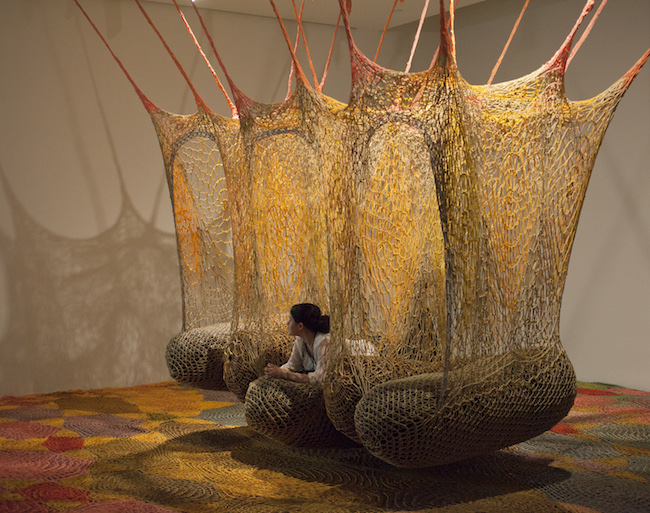
Ernesto Neto. [tapete campo] ondé ki nós vamo?, 2012; Velejando entre nós, 2013. Photo: Petri Virtanen, Kansallisgalleria | Finnish National Gallery
This morning at the press conference you said that you were afraid the first time you participated in a ritual....
Yes, of course. It's better to be afraid, because it's really strong. But you don't need to be afraid, you can trust them.
It also seems that, since the time of Adam and Eve, people have had a genetic fear of snakes.
We’re afraid of our neighbours, too. People are afraid of people. Yes, you’re going to pay attention, because a snake can bite you. So, this world of health and safety is not really safe at all. In this world we are going to become weaker and weaker, always protected, protected, protected...until we die. You know, life is about taking risks. It's OK to die. My mother, my grandmother have died, my grandfather has died, my ancestors, all of them are dead. But they are still here, somewhere. You know, it's OK. If you keep living with fear, what’s the point of living? Let's live, live....
In my work I'm always talking about life. You know, there are so many people talking about death. Forget about it – let's talk about life! Let's take Jesus off of this cross. Let's blow out all those crosses from the church. My dream is that one day we will arrive in all these churches and there will be just Jesus there. I can’t say that I'm devoted to Jesus. I respect Him, and I think that Jesus is great, and I really can sing for Jesus. But if you’re going to church to pray with an instrument of torture in your hand, how come, what do you think these church instruments are going to bring to you? Just suffering. More and more suffering. Get rid of it! Find other people, give them your hand, don't be afraid when you have love. True love. Loving condition or love in your heart. Have no fear, because it's fine, even if you die.
It's like I said earlier today, I was resigned to the fact that I was going to die. Fine, cool. Because I was on a spiritual dimension. Of course, I don't want to die; I want to live. I love being alive! I really love being alive. That’s what I'm trying to say to society through my work – live, life is good. What was the expression? [thinks] That’s because of all those years of drinking.... [laughs] To live – what for? It's like the poetry of Fernando Pessoa: “Navegar é preciso; viver não é preciso (Navigating is necessary; living is not).” To navigate is a precise necessity; to live is not a precise necessity.... It's time to live! Our ancestors were much stronger than us, their living conditions were much more difficult than ours. But they did not live with fear. You know, this guy who crossed the oceans, went to the jungle, met indigenous people and made love to indigenous women. The first Brazilian was the son of an Indian, as was the second, the third, the one hundredth and the one thousandth. I don't know how many. First with an indigenous woman, then with an African woman, and only then did the Europeans arrive. In fact, Brazilians are a mix of indigenous people, Africans and Europeans.
I'm very Nietzschean. We do what we want. I hate this blah, blah, blah.... You’re doing it because you want to, man. I hate these explanations like, “I would love to go to your party, but I can't go because this or that....” No, you’re not going because you don't want to go. Because you want to do something else. And you can't do two things at the same time. So, that's the thing. This is Friedrich Nietzsche. That’s the essence of his philosophy, in my opinion. We’re here doing what we want. We can create a gigantic line of excuses to say “I'm not doing this because of this; I'm doing this because of that,” but the reality is that I'm not doing this because I don't want to. And I'm doing this other thing because I want to do that instead. And we need to accept this and move on. It's like what he [Nietzsche] tried to say about the Superman – it's not about the power over the others; it's about how being true to yourself is the sacredness. You know, it’s quite simple, but it's difficult. And we all know it very well.
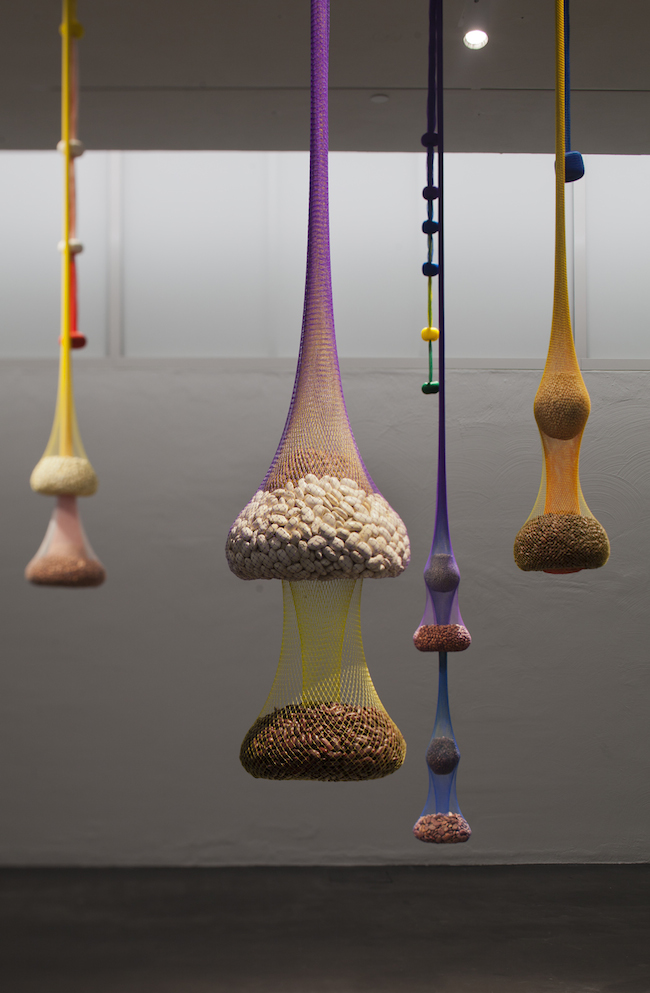
Ernesto Neto. Variation on Color Seed Space Time Love, 2009. Photo: Petri Virtanen, Kansallisgalleria | Finnish National Gallery
Speaking of rituals.... Nixi pae, mushrooms, meditation – in a way, each of those is a technical instrument. How important to this process is having a good and trustworthy teacher?
The first thing, you’ve got to drink [nixi pae] only when you’re ready. And you will know yourself when you are ready. Of course, if you’re a responsible person. You will feel a calling. Secondly, it’s very important to have a good shaman. We do the rituals in Rio de Janeiro with our friends, and we have the shamans, very trustworthy, and we have guardians. Because if you have, like, twenty people in a room who’ve never had the drink...it's a force, it's strong, and you have to take care.
Only responsible people were allowed to do the rituals. But as it started to spread out, there are also people who are not responsible, but who do them anyway. They make money with it. So, it's good that you asked this question, because this is very important. We are very serious with the people who do rituals. Only do them when you’re with a good shaman you can trust. Also, before a ritual, we always do a kind of interview with the people who wish to participate. About their history, their psychological condition, to find out how psychologically ready they are. For example, if you’re taking these red stripe medicines (prescription medicines that affect the central nervous system, such as sleeping pills, anti-anxiety medicines, medicines that lessen the symptoms of mental health problems – Ed.), you can't have the drink. It's very serious. It's not like you just come here and drink nixi pae.

Ernesto Neto. PedraGiboLagoDuaBusé (StonePythonDuaBuséLake), 2015. Courtesy Ernesto Neto. Installation view: Ernesto Neto and the Huni Kuin: Aru Kuxpia | Sacret Secret: TBA21-Augarten © Jens Ziehe, Vienna 2015
One thing is having serious shamans to lead the ritual, another thing is the environment in which it’s taking place. Your first experience took place in the rainforest, where the forest and all of the sounds in it alone make the environment special. But, if your first experience is in an exhibition hall in Vienna, it’s a completely different thing.
When you do it in a place like that, you have to prepare the field spiritually. And you need a secure place to do it. As I said before, the focus on “health” and “safety” today are the warriors of the apocalypse. Because these two words – “health” and “safety” – are just working for the capital, for profits. Because that’s the main aim of health and safety nowadays, in my opinion. You know, the scene is so sick, you have such an alarm system here at KIASMA that you can't even light a candle here. You go to church and you can light a candle there, so why can't you light a candle here in the museum? In a place of spirituality? This is sick, you know – we have to protect the art, blah, blah, blah.... The art is not going to get burned because you have a candle lit. You should be able to dim the light.
But security is very important to do rituals like that. And in the forest you are very protected because you have all these people around and they are all kind of like shamans. The whole society is a shamanic society. And you have all this forest protection, but it is much stronger, too.
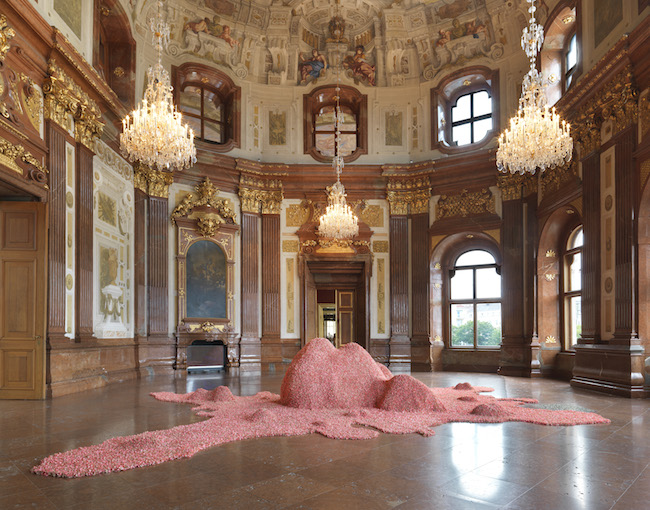
Ernesto Neto. O tempo lento do corpo que é pele, 2004. Thyssen-Bornemisza Art Contemporary Collection, Vienna. Installation view: Ernesto Neto and the Huni Kuin: Aru Kuxpia | Sacret Secret: TBA21-Augarten & Belvedere © Jens Ziehe, Vienna 2015
Speaking of safety, how legal was it to perform this ritual in Vienna? Considering the European Union’s regulations regarding psychoactive drugs and so on?
Yes, we did it, but, of course, it's also forbidden there. I would love to do the ritual here, but we have to wait six months to get special authorisation. But if they want, we are ready to do it.
After the ritual in Vienna, did you feel that it changed something in the participants?
A lot of people said thank you very much, they were so grateful to us and to all of it. Because it's something very special. Even if you only do it once in a lifetime, you see things that can be important for you. So, it's very good.
I'm really thinking about what’s the meaning of doing the exhibition here without the ceremony, and how I should continue this work. How can we spread this spirit of the boa constrictor around?
The average Sunday museum-goer, who might not know anything about all of this, might have a look at the exhibition and think, “This is all very nice, beautiful, decorative....” Of course, if you take off your shoes, you’ll get some more senses moving. But to actually get closer to the essence of this work of art – or any work of art, in fact – you need time....
People need time, because people nowadays have been grabbed by all of these problems, by the news. That’s the most important thing – to give people time. That's what I’ve been trying to do with this work for many years now. I did an exhibition in Malmö called The Malmö Experience. It was a gigantic room with all-white walls made of a cotton textile like t-shirt material. And you had to take off your shoes to go inside, and there were a lot of organic rooms and sculptures. That's my trajectory. When I came back for the closing of the exhibition, one of the security guys told me, “You know, I was here, and there were some teenagers, and one was telling the other, ‘Oh man, when my head is exploding, I come here; I stay here for a while and then I go.’” That's what my work is about.
But do you have time for yourself, considering that you’ve got exhibitions going on one after another?
Yes, it's the same thing I'm trying to get rid of. To do fewer exhibitions and to have more time for myself, for my family, for my friends, for the indigenous people, for the forest. So, that's what I need to do now, because I'm really exhausted and I think it's time to rethink all of it. But I, too, have been caught by this force, and I have this connection with art and with the boa. And now I'm rethinking.
Do you meditate when you begin a new work of art? Some people call it a blank slate, or an empty mind, but I assume that you need this feeling....
It's like meditating. You begin to take time for that, and things begin to appear. At the beginning, it’s all a little bit foggy, but over time the solutions and the presence of things begin to appear and to guide you on this painting or whatever you’re doing.
Is it still very important for you to make, maybe not all, but a part of your artwork with your own hands?
As an artist, you must be involved. I know how to do all of it here. Of course, there were a lot of people working on this exhibition, but it’s a very collective work. And I know how to do it all, how to fix something if needed.... I've developed this technique of crocheting, and I teach it to them. So, it's something we do together. It's good when you do things like that; if everybody could do an hour of crocheting every day, it would be very good for them.
Touch is very important in your work. You can touch, sit on and jump in the artwork.... At the same time, touch is the way children discover the world. Do you wish to use touch in order to wake the inner child in each of us? Like in that Santana song: “Let the children play....”
Yes, I think very much about this cognition moment in our life when we begin to touch things, to feel gravity, to feel temperature. I think it's very important for us to reconnect with this time in our lives, because with our mind we begin to be very much disconnected.
Neto is just your nickname. Do you also have a name given to you by the Huni Kuin people?
Txanayubē.
What does it mean?
“Txana” is the bird that sings many different songs. And when a pajé (shaman – Ed.) who is making the rituals starts to sing, he is calling for the txana. The artist is txana. “Yubē” is giboa, the boa constrictor.
Looking back, primitive tribes have influenced many artists, including Picasso. One of his favourite museums in Paris was the Museum of Man, and to some extent the African tribal masks displayed there inspired his Cubism period. You’ve said that the Huni Kuin people are also superb artists. Has their artwork in some way inspired you?
Yes, all the time. You know, pop music, which has been the force of the 20th century, happened only because of the Africans. It all came from the Africans, rock'n'roll and so on. Without them it would never have happened. Nobody is saying this properly. So, we are living from this fountain, but we are treating them like idiots.
When you told us your story about meeting the indigenous people for the first time, I kept thinking about how you, by living in Brazil, had actually always been so close to them. Geographically, I mean. But physically, you really met them only relatively recently.
Yes, you’re close because they are inside of you, but you’re also very far away because there are huge cultural barriers created in our minds. Like the education we receive, which is very European in Brazil. So, the distance becomes very far.
Before this interview, I watched a few of your earlier public presentations on YouTube. Your body language and the way you moved about the room was completely different back then – temperamental and exuberant. But now, you’re sitting across from me so quietly and calmly. It’s like I’m talking to a completely different person.
Yes, some people complain about that. My kids as well. “What did you do? These sculptures are boring.... We don't play anymore.... Just going there and sitting down and breathing – boa, boa, sacred and blah, blah, blah....” I don't drink anymore.
But at what age do you think you’ll bring your kids to the rainforest?
Whenever they want. I’ve already invited them. We did our first ritual in Bilbao, and my younger one, he wanted to drink the nixi pae. He said to the Huni Kuin leader – why can’t I drink it? I don't think his mother will let him, was the answer. But I hope that sooner or later they will drink it.
Indigenous children begin to drink nixi pae when they’re about seven or eight years old. It's like we’re all educated to drink alcohol, from the very beginning. Our parents drink, and we need to know how, we need to learn how to drink, because alcohol is very strong. So, we all went through it – vomiting a lot, having those heavy drinks, then adding some refreshing drink to make it easier to drink.... It's absolutely necessary in order to survive in a society where drinking is a part of social life. You’re going to drink at dinners, you’re going to drink at parties, you’re going to drink at openings, you’re going to drink everywhere. You really need to know how to drink, how not to fall apart. But there, in the jungle, they need to learn how to drink their spiritual drink.
Steve Jobs once said that using LSD was one of the most important things in his life, because it expanded the boundaries of his consciousness. Others might use “mushrooms” or deep meditation to achieve the same thing....
But for the indigenous who use mushrooms, mushrooms are their secret medicine. They’re not a drug. Tobacco is a secret medicine. Nowadays tobacco is forbidden to have here; instead, we have cigars and cigarettes – it’s like the revenge of tobacco. The way it’s used is what makes the difference. The Africans, they use alcohol also to connect. Shamans who are from the coca-growing area, they also say that cocaine is the revenge of the leaf produced by the industry and Western society. Cocaine today is a huge problem, a real poison, which is helping the cross to put the dark, negative force into our lives.
All of your artwork is in some way about joy, about happiness. It seems like an illusion in our world sometimes, doesn’t it?
No, it's not about happiness and pleasure; it's about joy. Joy is also about serenity, about being relaxed with yourself. It's not like just party, party, party.... That kind of joy is just an escape from the heavy society we are living in now. You escape for a moment, but you fall down in another day. I'm talking about responsibility, and responsibility brings joy. What is a serious person? It’s a person who has a face like this.... A serious person can be smiling, so it's what you have inside of you instead. What you spread around. There are a lot of people who look like serious people, but at the end of the day it's just a face. So, these are the things you need to rethink about. Because there are a lot of people being killed, a lot of people being crushed, and this is not good. These people deserve joy.
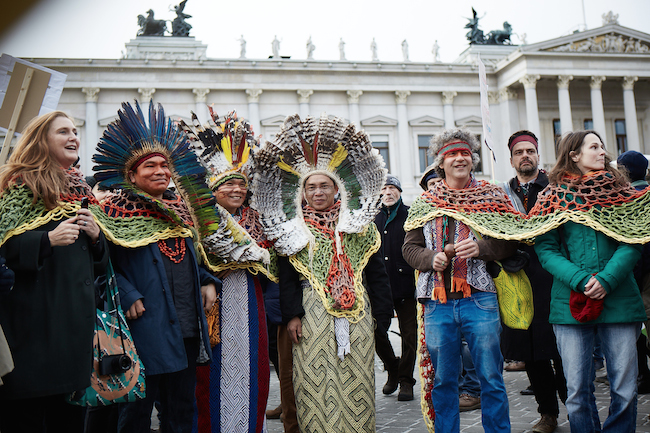
March for climate change, Vienna, 2015, Photo © Sandro Zanzinger/TBA21
But indigenous tribes have also always warred among themselves and killed each other....
It happens everywhere. They also don't think that they are angels.
But do you think art really has the power to change anything?
I don't know. I think it can change a few people. And maybe these few people can change others. But at least you have an exhibition here, people come here and they can rest, they can breathe for a while. But giving all of the responsibility to change things to art is the same mistake as giving all of the responsibility to change the world to indigenous people. Because the responsibility belongs to all of us, whether we’re artists or not. Feeling the artist inside of each one of us. We are all artists, we are all the same.
So Joseph Beuys was right?
Yes, Beuys was right. I’ve always felt that. One is not bigger or more special than the other. We are all the same. It's very important to think about multiculturalism, too. Especially for the West, because the West is the one that doesn't respect others. You know, in Brazilian stadiums we had a place where people could watch games standing up. When you dance the samba, you dance like this [gets up]; you can't dance the samba sitting down. But when you dance rock'n'roll, you can dance like this [gesticulates while seated]: “I can’t get no satisfaction.....” So, why should you have to watch the game sitting down? Because this is the European point of view. When someone goes to a stadium and says that everyone should be sitting down, it's the arrogance of the West towards the rest of the world.
You have the Brazilians and the Latvians, and they are very different. And then you have people from São Paulo and people from Rio de Janeiro, and they’re very different, too. And then you have people from Ipanema and people from Copacabana, and then you have two best friends who have a difference between them. And suddenly we’re not talking about culture anymore. Multiculturalism ends up in no culture. So, culture separates us, but nature unifies us. For example, we all need to go to the toilet. You’re sitting at the table, drinking a beer with your friends, discussing a lot of things, magnetised by this cultural environment, and suddenly a voice comes to you, “OK, Neto, let's go...let's go....” You tell it, “No, no....” But, in a way, you need to go. Suddenly, you can't stand it anymore and you stand up, and as soon you do it, you start (uffff....) to feel much more connected to yourself. Introspective. And then you begin to go to the toilet. You arrive at the toilet and you pee and you pee and you feel all this energy, all this infinity, all this nature that is inside of you. You come back to the table refreshed with new ideas, with new stories. And what was this desire to pee? Nature. This was nature inside of us. Nature is stronger than culture. That’s proof of it, you know. You suddenly have to get out of this cultural environment and go be with nature.
A lot of art collectors I’ve interviewed say that art makes them happy, that art has made them better people. You’ve met a lot of them. Do you believe it?
(Laughs) Yes, it happens, too, because at least they begin to think about other things than money. There’s a lot of great art, and there are a lot of great people doing art. I think art has a spirituality, and when you have art in your home, it can spread this spirit around. But it can also become an all-consuming issue. It's difficult to generalise. It's better to talk about each case individually.
Is it important for you where your works of art end up?
I have no idea where they go. Go, try to help these people, be together with them, do your living in this life. It's like this.
If everything is nature, than a work of art is also nature. It’s alive, isn’t it?
It's alive. But as the Huni Kuin people say, you need to cure all the time. Art collectors, they collect to cure all the time, too. But it can become like a cigarette – tobacco is there to cure, but if you use tobacco all the time, it becomes a poison. So, like a medicine. The difference between a poison and the light is the dose. It's the same thing with capitalism or industry. The thing we’re doing with the planet is a matter of dose. The way we’re going now, we’re overdosing.
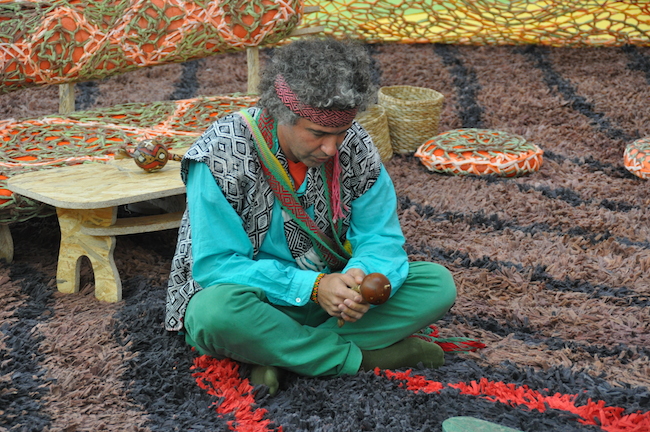
Ernesto Neto. Photo: Ainars Erglis
Is it the same with art?
The same. Even with artists, if they make one painting after another, one work after another, and begin to do more or less the same thing all the time because there’s market demand, they become a slave to the market. Like I said about the guys who became slaves to wheat. So, this is something I also think about.
There’s always a risk. But, you know, there are many positive things around us, too. I see it everywhere. And they are all the fruit of that time. That openness of the Huni Kuin people for society is a fruit of that time. This boa here is a fruit of that time. There are people to reach and people who are ready to talk about it. That's what I said, when Europeans arrived in America five hundred years ago, I don't think they had the maturity to understand the intelligence that was there. But now, I think, they have this maturity. There is a time for encounter, for sharing, and there are a lot of great and positive things coming from the West as well. If the West becomes less arrogant – and, I think, the West is becoming less arrogant (but not the institutions, the money makers) – things will start to change.
Rirkrit Tiravanija, the great artist from Thailand, is talking about that, too. But there are also these clubs on the art scene, which are a little bit annoying. When I arrived in Europe, I wanted to share, but I began to realise that there’s a whole system of different clubs. I didn't know how to deal with it, how to interact. They have their own politics, and sometimes there are really great artists in a club, but sometimes there are also artists who are not so great but they’re surfing on the same wave. They’re friends of friends, social acquaintances, etc.... And for them, this social life is a way to survive on the scene. I suppose they might be happier if they just went to their studios and made some art. But who am I to say. I'm saying all these things, but I'm just here to learn. I'm sitting here, saying these things, but really I'm here to learn.